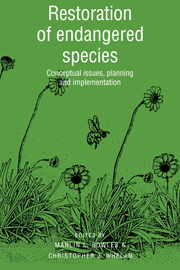Book contents
- Frontmatter
- Contents
- List of contributors
- Foreword
- Acknowledgments
- I Conceptual issues in restoration ecology
- II Restoration planning
- III Implemented restorations
- 10 The swift fox reintroduction program in Canada from 1983 to 1992
- 11 Restoration of the endangered black-footed ferret: a twenty-year overview
- 12 Development and implementation of a recovery program for the federally threatened Lakeside daisy (Hymenoxys acaulis var. glabra)
- 13 Demographic monitoring and the recovery of endangered plant populations
- IV Synthesis and future directions: biology, politics and reality
- Taxonomic Index
- Subject Index
10 - The swift fox reintroduction program in Canada from 1983 to 1992
Published online by Cambridge University Press: 27 January 2010
- Frontmatter
- Contents
- List of contributors
- Foreword
- Acknowledgments
- I Conceptual issues in restoration ecology
- II Restoration planning
- III Implemented restorations
- 10 The swift fox reintroduction program in Canada from 1983 to 1992
- 11 Restoration of the endangered black-footed ferret: a twenty-year overview
- 12 Development and implementation of a recovery program for the federally threatened Lakeside daisy (Hymenoxys acaulis var. glabra)
- 13 Demographic monitoring and the recovery of endangered plant populations
- IV Synthesis and future directions: biology, politics and reality
- Taxonomic Index
- Subject Index
Summary
Introduction
The swift fox (Vulpes velox), the smallest North American canid, disappeared from the Canadian prairies in the 1930s, about fifty years after the demise of the bison (Bison bison). These changes were symbolic of a much larger trend. In less than 100 years the northern prairie ecosystem, which had developed over 10 000 years, was transformed so dramatically that nine vertebrate species disappeared from it. Almost 80% of the mixed-grass biome disappeared (World Wildlife Fund Canada 1988). Modern agricultural practices were primarily responsible for these rapid changes, and transportation corridors, oil and gas exploration, and industrial activities put pressure on what little native prairie remained. Currently, global climatic trends could affect the remaining islands of natural prairies. Restoration of the swift fox to the Canadian prairie landscape has therefore become an important symbolic gesture, focusing attention on the need for protection and restoration, to the extent still possible, of a greatly threatened ecosystem. In this chapter, we describe the background and accomplishments of the Canadian swift fox reintroduction program.
Biological background
Taxonomy
The first records of swift foxes in North America are in a reference of fur shipments from the Pembina post of the Northwest Company's Red River District in 1801 (Fauna West 1991); however, the swift fox was not taxonomically described until 1823 (T. Say in James 1823).
Merriam described two subspecies of swift foxes; the northern (Vulpes velox hebes), and the southern (Vulpes velox velox) (Merriam 1902).
- Type
- Chapter
- Information
- Restoration of Endangered SpeciesConceptual Issues, Planning and Implementation, pp. 247 - 271Publisher: Cambridge University PressPrint publication year: 1994
- 21
- Cited by



